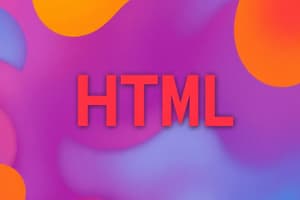Podcast
Questions and Answers
Which of the following accurately describes the relationship between HTML, CSS, and JavaScript in web development?
Which of the following accurately describes the relationship between HTML, CSS, and JavaScript in web development?
- HTML provides the structure, CSS provides the styling, and JavaScript provides the interactivity. (correct)
- HTML provides styling, CSS provides structure, and JavaScript provides interactivity.
- HTML, CSS, and JavaScript all provide structure, styling, and interactivity equally.
- HTML provides interactivity, CSS provides the structure, and JavaScript provides the styling.
Consider a scenario where you need to embed a video on a webpage while also providing fallback content for browsers that do not support the <video> element. Which approach is most appropriate?
Consider a scenario where you need to embed a video on a webpage while also providing fallback content for browsers that do not support the <video> element. Which approach is most appropriate?
- Using the `<embed>` tag with a link to the video file and ignoring fallback options.
- Using the `<object>` tag without any fallback mechanism.
- Using the `<img>` tag and setting the `src` attribute to the video file.
- Using the `<video>` tag, including `<source>` elements for multiple video formats, and providing fallback content within the `<video>` tags. (correct)
You are designing a form that requires users to accept terms and conditions before submission. Which HTML input type is most suitable for this purpose, and what attribute should be used to ensure the form cannot be submitted without acceptance?
You are designing a form that requires users to accept terms and conditions before submission. Which HTML input type is most suitable for this purpose, and what attribute should be used to ensure the form cannot be submitted without acceptance?
- `<input type="checkbox">` with the `required` attribute. (correct)
- `<input type="text">` with the `required` attribute.
- `<input type="button">` with the `required` attribute.
- `<input type="radio">` with the `required` attribute.
When developing a website with accessibility in mind, which of the following practices is most important for users who rely on screen readers?
When developing a website with accessibility in mind, which of the following practices is most important for users who rely on screen readers?
Which of the following code snippets best demonstrates the correct way to link an external CSS stylesheet named styles.css to an HTML document?
Which of the following code snippets best demonstrates the correct way to link an external CSS stylesheet named styles.css to an HTML document?
Which of the following HTML structures is most semantically correct for representing the primary navigation section of a webpage?
Which of the following HTML structures is most semantically correct for representing the primary navigation section of a webpage?
Given an HTML form with several input fields, what is the primary function of the <label> tag, and how does it enhance usability and accessibility?
Given an HTML form with several input fields, what is the primary function of the <label> tag, and how does it enhance usability and accessibility?
You want to incorporate a YouTube video into your webpage, allowing it to play inline within your content. Which HTML element is most appropriate for this purpose, and what attributes are essential for specifying the video's source and dimensions?
You want to incorporate a YouTube video into your webpage, allowing it to play inline within your content. Which HTML element is most appropriate for this purpose, and what attributes are essential for specifying the video's source and dimensions?
Consider a situation where you need to display a copyright symbol (©) in your HTML content. Which of the following methods is the most correct and semantically appropriate way to achieve this?
Consider a situation where you need to display a copyright symbol (©) in your HTML content. Which of the following methods is the most correct and semantically appropriate way to achieve this?
You are designing a website with multiple pages and want to link these pages together. What is the difference between using absolute and relative URLs for the href attribute in the <a> tag, and when would you use each type?
You are designing a website with multiple pages and want to link these pages together. What is the difference between using absolute and relative URLs for the href attribute in the <a> tag, and when would you use each type?
You are tasked with creating a table that displays product information. Some product descriptions are quite lengthy and need to span multiple columns for better readability. How would you achieve this using HTML table attributes?
You are tasked with creating a table that displays product information. Some product descriptions are quite lengthy and need to span multiple columns for better readability. How would you achieve this using HTML table attributes?
A webpage contains both and elements. The CSS includes a style rule that targets elements with font-weight: bold;. How will these elements be rendered in most browsers?
A webpage contains both and elements. The CSS includes a style rule that targets elements with font-weight: bold;. How will these elements be rendered in most browsers?
You are designing a webpage and want to ensure that certain structural elements, like navigation menus and footers, are easily identifiable for styling and scripting purposes. Which approach is most appropriate for applying unique styles and behaviors to these elements?
You are designing a webpage and want to ensure that certain structural elements, like navigation menus and footers, are easily identifiable for styling and scripting purposes. Which approach is most appropriate for applying unique styles and behaviors to these elements?
You're creating a webpage with embedded images, but some users are reporting that images are not displaying correctly. To ensure better accessibility and provide useful information in such cases, which attribute should you always include in the `` tag?
You're creating a webpage with embedded images, but some users are reporting that images are not displaying correctly. To ensure better accessibility and provide useful information in such cases, which attribute should you always include in the `` tag?
How can you ensure that external website links open in a new tab or window when clicked, providing a seamless user experience by keeping users on your site?
How can you ensure that external website links open in a new tab or window when clicked, providing a seamless user experience by keeping users on your site?
Flashcards
What is HTML?
What is HTML?
The standard markup language for creating web pages, providing the structure for content like text and images.
What is <!DOCTYPE html>?
What is <!DOCTYPE html>?
The declaration that defines the document type and HTML version. It should be the first line in an HTML document.
What are HTML attributes?
What are HTML attributes?
Additional information about an HTML element, specified within the start tag, usually in name-value pairs (e.g., id="header").
What are HTML forms?
What are HTML forms?
Signup and view all the flashcards
What are HTML entities?
What are HTML entities?
Signup and view all the flashcards
What does the <html> tag do?
What does the <html> tag do?
Signup and view all the flashcards
What is the purpose of the <head> element?
What is the purpose of the <head> element?
Signup and view all the flashcards
What do the <h1> to <h6> tags define?
What do the <h1> to <h6> tags define?
Signup and view all the flashcards
What does the <a> tag define?
What does the <a> tag define?
Signup and view all the flashcards
What is the role of the <img> tag?
What is the role of the <img> tag?
Signup and view all the flashcards
What does the <body> tag contain?
What does the <body> tag contain?
Signup and view all the flashcards
What does the alt attribute do?
What does the alt attribute do?
Signup and view all the flashcards
What does the <strong> tag define?
What does the <strong> tag define?
Signup and view all the flashcards
What is the <div> element?
What is the <div> element?
Signup and view all the flashcards
What is the id attribute?
What is the id attribute?
Signup and view all the flashcards
Study Notes
- HTML (HyperText Markup Language) is the standard markup language for web page creation
- HTML outlines the web page structure
- HTML elements instruct browsers on how to display content
- HTML files must have the ".htm" or ".html" extension
HTML Structure
- HTML documents begin with a
<!DOCTYPE html>declaration - The
<html>element is the root element of an HTML page, with<head>for metadata and<body>for visible content - The
<head>element contains meta-information about the HTML page, such as the title, character set, styles, and links to scripts - The
<title>element specifies a title shown in the browser's title bar or tab - The
<body>element defines the document's body and contains the visible page content (headings, paragraphs, images, hyperlinks, tables, lists, etc.)
HTML Elements
- HTML elements are defined by a start tag, some content, and an end tag:
Content - Some HTML elements have no content (like the
<br>element); these are called empty elements and do not have an end tag - HTML tags are case-insensitive, but lowercase tags are recommended for readability and consistency
Basic HTML Tags
<h1>to<h6>tags define HTML headings, with<h1>as the most important and<h6>as the least- The
<p>tag defines a paragraph - The
<br>tag inserts a single line break and is an empty element - The
<hr>tag defines a thematic break in an HTML page (a horizontal rule), is an empty element, and often separates content
HTML Attributes
- HTML attributes provide additional information about HTML elements, usually in
name="value"pairs within the start tag - The
hrefattribute of the<a>tag specifies the URL:<a href="URL">Visit Example</a> - The
srcattribute of the<img>tag specifies the image path:<img src="URL"> - The
altattribute of the<img>tag provides alternative text if the image display fails; it's important for accessibility - The
widthandheightattributes of the<img>tag specify the image dimensions in pixels - The
styleattribute adds styles to an element:<p style="color:blue;">This is a blue paragraph.</p> - The
langattribute declares the language of the Web page:<html lang="en"> - The
titleattribute defines extra information, often displayed as tooltip text on mouse hover:<p title="Info">This is a paragraph.</p> idspecifies a unique identifier for the elementclassspecifies one or more class names for the element, used for styling with CSS
HTML Formatting
<b>tag defines bold text<strong>tag defines important text, also displayed as bold<i>tag defines italic text<em>tag defines emphasized text, also displayed as italic<mark>tag defines marked or highlighted text<small>tag defines smaller text<del>tag defines deleted (removed) text<ins>tag defines inserted (added) text<sub>tag defines subscript text<sup>tag defines superscript text
HTML Comments
- HTML comments are not displayed in the browser but document the HTML source code, starting with
<!--and ending with-->
HTML Lists
- HTML supports ordered, unordered, and description lists
- The
<ul>tag defines an unordered (bulleted) list - The
<ol>tag defines an ordered (numbered) list - The
<li>tag defines a list item - The
<dl>tag defines a description list - The
<dt>tag defines a term/name in a description list - The
<dd>tag describes each term/name in a description list
HTML Links
- HTML links are hyperlinks
- Clicking a link jumps to another document
- The
<a>tag defines a hyperlink, with thehrefattribute specifying the destination address - By default, links are underlined and blue (unvisited), underlined and purple (visited), and underlined and red (active)
- The
targetattribute specifies where to open the linked document;target="_blank"opens it in a new tab or window - Absolute URLs link to another website
- Relative URLs link to a page within the same site
- An image can be used as a link
HTML Images
- The
<img>tag embeds an image, with thesrcattribute specifying the URL, and thealtattribute providing alternative text if the image cannot be displayed - The
widthandheightattributes specify the image dimensions in pixels - Images are linked to HTML pages, with the
<img>tag creating a holding space
HTML Tables
- HTML tables arrange data into rows and columns
- The
<table>tag defines an HTML table - The
<tr>tag defines a table row - The
<th>tag defines a table header - The
<td>tag defines a table cell (data cell) - The
borderattribute specifies whether the table has a border - The
colspanattribute specifies the number of columns a cell should span - The
rowspanattribute specifies the number of rows a cell should span
HTML Blocks and Inlines
- Block-level elements start on a new line and take up the full width available:
<div>,<p>,<h1>-<h6>,<ul>,<ol> - Inline elements do not start on a new line and only take up as much width as necessary:
<a>,<span>,<img> - The
<div>element is a block-level container for other HTML elements - The
<span>element is an inline element used to group inline elements for styling
HTML Classes
- The
classattribute specifies a class name for an HTML element - Multiple HTML elements can share the same class
- Class names are case-sensitive
- Classes style or manipulate elements in CSS and JavaScript
HTML IDs
- The
idattribute specifies a unique ID for an HTML element; only one element per document can share the same ID - ID names are case-sensitive
- IDs style a specific element in CSS or manipulate it in JavaScript
- HTML5 offers semantic elements to define different parts of a web page
<header>specifies a header for a document or section<nav>Defines a set of navigation links<article>defines an article<section>defines a section in a document<aside>defines content aside from the page content<footer>Specifies a footer for a document or section<main>specifies the main content of a document<figure>and<figcaption>used for self-contained content like images with captions<iframe>tag specifies an inline frame, embedding another HTML document
Accessibility
- Accessibility in HTML involves designing and developing web pages usable by people with disabilities
- Providing alternative text for images using the
altattribute - Using semantic HTML elements to structure content
- Ensuring sufficient contrast between text and background colors
- Making forms accessible by using labels for input fields
- Providing keyboard navigation
- Using ARIA (Accessible Rich Internet Applications) attributes to enhance the accessibility of dynamic content
- Providing alternative text for images using the
- HTML forms are used to collect user input
- The
<form>element defines a form, which contains various input elements - The
actionattribute of the<form>element specifies the URL where the form data should be sent when the form is submitted - The
methodattribute specifies the HTTP method (e.g., "get" or "post") used to submit the form data - Common input types include:
textfor single-line text inputpasswordfor password input (characters are masked)checkboxfor selecting one or more optionsradiofor selecting a single option from a groupsubmitfor submitting the formresetfor resetting the form fields to their default valuesemailfor email address input (with validation)numberfor numeric input (with validation)datefor date inputfilefor uploading files
- The
Best Practices
- Use a consistent coding style for readability and maintainability
- Validate HTML code using online validators or browser developer tools
- Optimize images for web use to reduce page load times
- Use comments to document code
- Keep HTML, CSS, and JavaScript code separate for better organization
- Test web pages in different browsers and devices to ensure cross-browser compatibility
- The
styleattribute adds styles to an element, such as color, font, size, and more - CSS (cascading style sheets) is generally preferred for styling HTML elements
- HTML structures content, while CSS (Cascading Style Sheets) styles appearance
- CSS can be applied inline (using the
styleattribute), internally (using the<style>element in the<head>), or externally (using a separate CSS file linked in the<head>) - External CSS is the recommended approach for maintainability and reusability
- CSS rules consist of selectors (that target HTML elements) and declarations (that specify the styles to apply)
- HTML provides the structure, CSS provides the styling, and JavaScript provides interactivity and behavior to web pages
- JavaScript code can be embedded within
<script>tags in the HTML document or linked from external.jsfiles - JavaScript can be used to manipulate HTML elements, handle events, perform calculations, and communicate with servers
- JavaScript code can be embedded within
- Character entities display reserved or invisible characters
- Some characters are reserved in HTML and have special meanings, such as
<and& - To display reserved characters use character entities
- A character entity looks like:
&entity_name;or&#entity_number; - HTML entities display characters that are reserved or not typed easily typed on a keyboard
- Entities start with an ampersand (
&) and end with a semicolon (;)<represents the less than sign (<)>greater than sign (>)&represents the ampersand (&) represents a non-breaking space©represents the copyright symbol (©)
- Some characters are reserved in HTML and have special meanings, such as
- URLs (Uniform Resource Locators) are web addresses
- URLs can be absolute or relative
- An absolute URL points to another website
- A relative URL points to a file within a website
- The
<script>tag embeds a client side script (JavaScript)- Script elements either contain scripting statements or point to an external script file through the
srcattribute - JavaScript is commonly used for dynamic content, interactivity and animations
- Script elements either contain scripting statements or point to an external script file through the
Studying That Suits You
Use AI to generate personalized quizzes and flashcards to suit your learning preferences.




